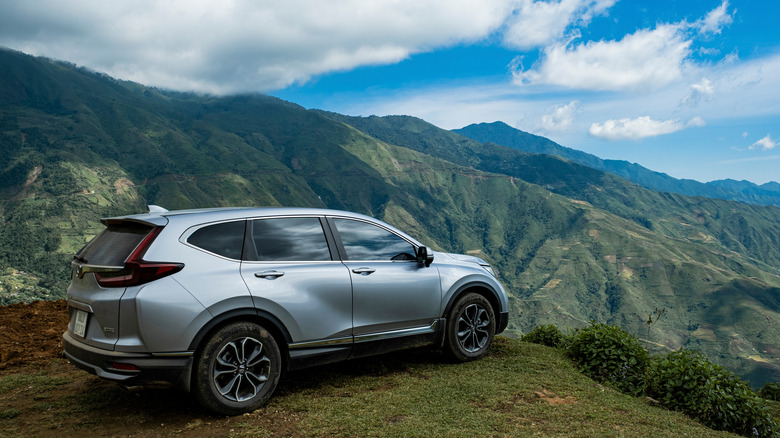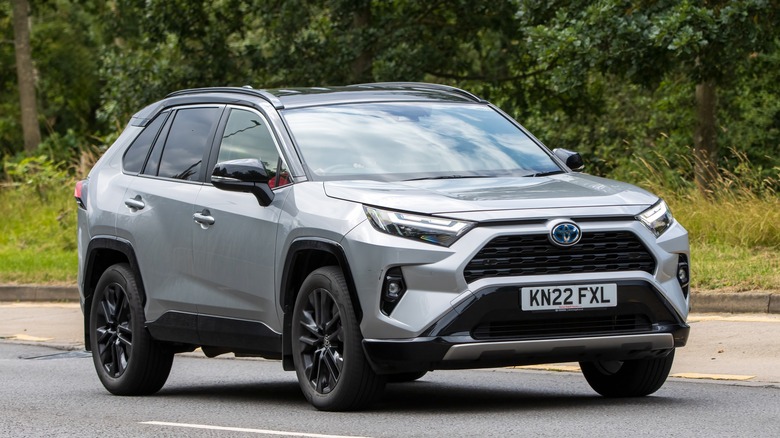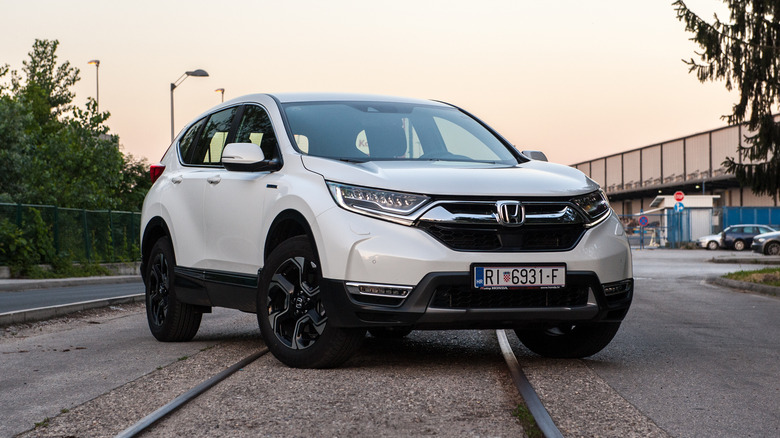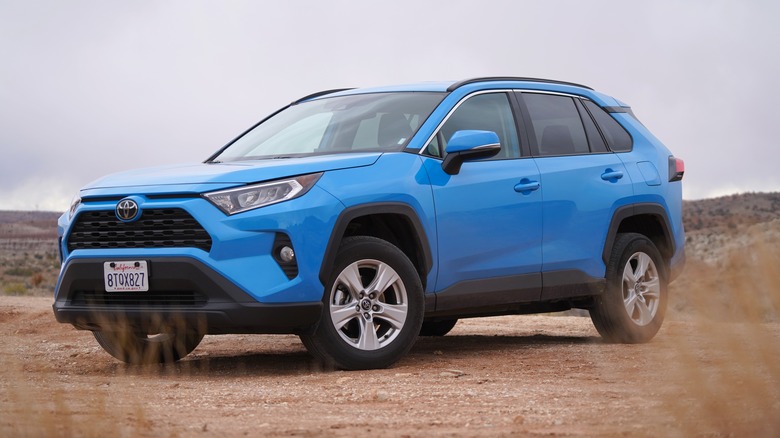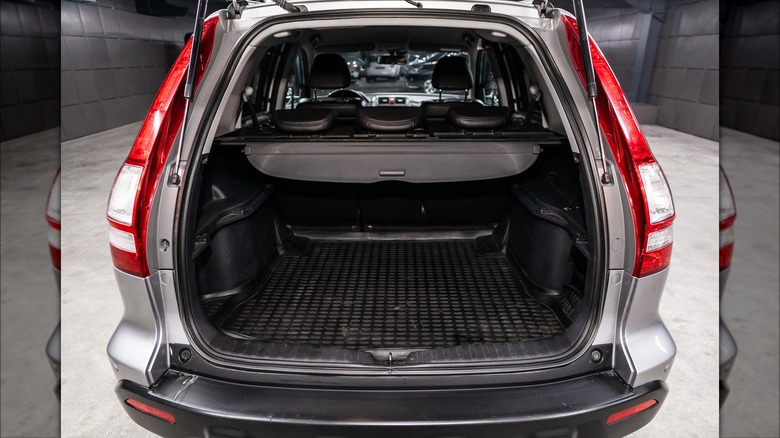Toyota RAV4 Vs. Honda CR-V: Which Compact SUV Is Right For You?
Compact SUVs have become popular lately because they're just right for many people. They're not too big or small, and they can do many things well. Drivers are also drawn to their higher driving position, spacious interiors, and cargo capacity, which rival those of larger SUVs. In this market, Toyota and Honda have carved out their niche and become famous for making cars — the RAV4 and the CR-V, respectively — that work well and don't break the bank.
Picking the better compact SUV is a tough job, though, especially when each has pros and cons and ultimately boils down to what you consider important. So, in this article, we'll be looking at the strengths and weaknesses of these two SUVs to help you make a more informed decision.
To compare and contrast, we'll focus on three key criteria: how well these SUVs perform and what features they offer, how comfortable and roomy they are, and how fuel-efficient they are. These things help us figure out if they're a good deal for different people.
Besides official Honda and Toyota documentation and our own reviews, we'll also use professional reviews published by reputable sources like MotorTrend, Car and Driver, and Top Gear to compare technical aspects of the SUVs. We will also check out what folks who own these vehicles have to say about the more subjective elements like comfort and riding experience.
What is the Toyota RAV4?
The Toyota RAV4 is like a car that grew up with the times. It started in 1989 as a concept called RAV Four, and by 1994, it was a real car in Japan, Europe, and the U.S. This car was unique because it combined the fun of an off-road vehicle with the comfort of a regular car. Toyota even gave it a quirky name, RAV4, which stands for "Recreational Active Vehicle with 4WD."
Initially, there were different types of RAV4s, from two-door versions to an all-electric one. People seemed to like them because Toyota sold almost 300,000 in the first three years. Over the years, Toyota made changes to keep it exciting, and in 2016, they introduced the RAV4 Hybrid — it was powerful and, more importantly, didn't use too much fuel. The RAV4 was Toyota's best-selling car in the U.S. in 2022, and we think the Toyota RAV4 deserves its American sales success for three reasons.
The Toyota RAV4 appeals to those who are looking for a compact SUV that's practical, intelligent, and fuel-efficient. It's great for families looking for a spacious, safe vehicle to handle various terrains without venturing into hardcore off-roading. But the RAV4 may not be for the enthusiasts who crave manual transmissions or a high-performance engine. If you prefer the feel of a traditional SUV and aren't interested in hybrid technology, you might want to explore other options. The RAV4 is all about being sensible and saving money on gas.
What is the Honda CR-V?
The Honda CR-V, short for Comfortable Runabout Vehicle, is a compact sport utility vehicle that has been extremely popular since its U.S. debut in 1997. With nearly six million units sold in the U.S., it has held the title of America's best-selling CUV since its launch and has been the top-selling Honda vehicle since 2017.
When the first CR-V came out, it was different from other SUVs. It had car-like ride quality thanks to its unibody construction, four-wheel independent suspension, and generous wheelbase. It introduced features like Real Time 4WD, offering confident off-road capability and 8.1 inches of ground clearance. And guess what? The back of the car could turn into a picnic table! Compared to Toyota's SUVs like the RAV4, the CR-V often wins with its reputation for reliability and strong resale value.
It's roomy inside, comfy to ride in, and saves gas. So, it's great for commuters, young families, and anyone who values a smooth ride and ample cargo space. The CR-V's impressive reliability also makes it a wise choice for those looking for long-term value. If you want a car that goes really fast or goes off-road, the CR-V isn't the best. It's more about being comfy and practical. It's not for thrill-seekers or people who love going on big adventures. Ultimately, the CR-V and RAV4 are close competitors, so we'll need to look at the details to see which is right for you.
Performance and features
Under the hood of the RAV4, you'll find a 2.5-liter four-cylinder engine pumping out 203 horsepower and 184 pound-feet of torque, mated to an eight-speed automatic transmission. The RAV4 is quicker than its old version, taking eight seconds to go from 0 to 60 mph. If you choose the RAV4 Hybrid, it's even quicker, taking just 7.4 seconds.
The RAV4 also offers standard driver assistance features, including automated emergency braking with pedestrian detection, lane-departure warning with lane-keeping assist, and adaptive cruise control. However, it's worth noting that some advanced safety features, like blind-spot monitoring and rear-cross-traffic alert, are optional on the base model and come at an additional cost. So, if you want a bit more oomph and fancy tech, go for one of the upgraded RAV4 models.
Honda's CR-V, on the other hand, relies on a 190-hp turbocharged 1.5-liter four-cylinder engine paired with a continuously variable automatic transmission (CVT). While not as quick as the RAV4, it still offers a respectable 0–60 mph time of 8.3 seconds for non-hybrid versions. If you pick the hybrid version, it's a bit quicker, taking 7.9 seconds to go from 0 to 60 mph.
When it comes to driver safety features, the CR-V includes forward-collision warning, automated emergency braking, lane-keeping assist, and lane-departure warning as standard features. Additionally, Honda has added some extra safety goodies, such as blind-spot monitoring, traffic sign recognition, and a rear-seat reminder. If safety plays a more significant part in your buying decision, then the CR-V is for you.
Fuel efficiency
The RAV4 is great if you want to save on gas. The RAV4 Prime, in particular, can go 48 miles using just electricity. But here's the catch: the RAV4 Prime costs more upfront than the regular RAV4 Hybrid. So, even though you save on gas, it might take a while to make up for the extra money you spent. The regular RAV4 is also pretty good on gas, especially if you choose the front-wheel-drive version. It can get up to 35 miles per gallon on the highway. The starting price for the 2024 RAV4 hovers around $28-30,000, depending on the model, which is pretty reasonable.
If you're eyeing the Honda CR-V, it has two engine options — a peppy 1.5-liter gas engine and a more efficient 204-hp hybrid setup. The regular CR-V can get up to 30 miles per gallon, while the hybrid version is a champ with 40 miles per gallon in the city, as per our 2023 Honda CR-V review. The starting price for the 2024 CR-V is $29,500 for the base model and $33,350 for the hybrid version.
So, if you want to save on gas and don't mind spending a bit more upfront, the RAV4 is a good choice. On the other hand, if you want a solid car with a good hybrid option, the CR-V is worth a look. It really depends on what you're looking for in a car.
Comfort and space
Riding comfort and cargo space are major considerations when picking out an SUV. So, how do these two vehicles do in this department?
The RAV4 has a big, cozy cabin that can fit five people with ease. The seats are plush and supportive, though some reviewers mention that they might feel stiff during long rides. When it comes to cargo space, the RAV4 does well, too. You've got 37.6 cubic feet of room behind the rear seats, and when you fold those seats down, you get a generous 69.8 cubic feet. This is great if you have lots to carry. Plus, the battery doesn't steal cargo space, so it's practical. However, users note that it can get noisy at high speeds, and the ride can be a bit bumpy.
The 2024 Honda CR-V also scores high in comfort and space. Its cabin is comfy and spacious for both front and rear passengers. The front seats are cushy and have lots of room for your head and legs. In the back, there's space for adults, but the seats aren't as cushy as the front ones. The good thing is that the rear seats can recline for more comfort. When it comes to cargo, you get 39.3 cubic feet behind the rear seats, and if you fold them down, you get a massive 76.5 cubic feet. Besides being comfortable, the CR-V is quiet when in electric mode.
